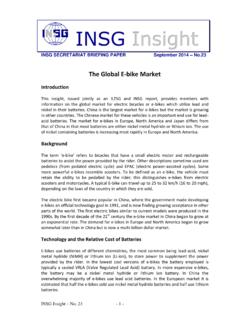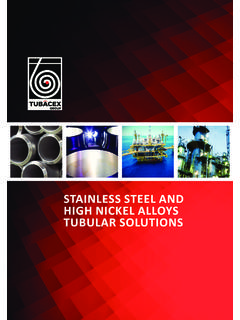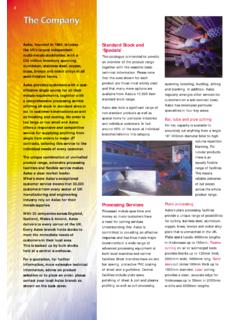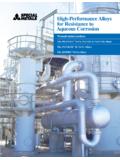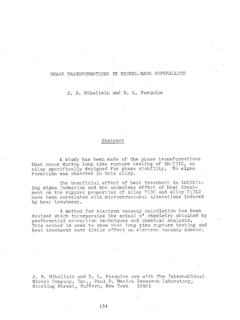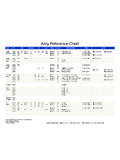Transcription of Nickel-Based Super Alloys - insg.org
1 INSG Insight INSG SECRETARIAT BRIEFING PAPER April 2013 Nickel-Based Super Alloys Introduction This Insight report, the twentieth in the series of INSG Insight briefing reports, provides members with information on one of the many downstream uses of nickel ; the use of Nickel-Based Super Alloys . This report is intended to contribute to a better understanding by member countries on the dynamics driving the nickel market. The use of nickel in Nickel-Based Super Alloys other than stainless steel is one of the principal markets for nickel . According to the nickel Institute, the term Super alloy is applied to Alloys which have outstanding high temperature strength and oxidation resistance.
2 nickel - based superalloys may contain alloying additions of chromium, cobalt, aluminium, titanium, rhenium, ruthenium and other elements. Often components are produced by carefully controlled solidification in order to get an optimum directionally solidified or single crystal structure. Components fabricated from Super Alloys can have strengths at 1000 C which exceed that of ordinary steels at room temperature. They are essential in the hottest parts of gas turbines both for power generation and aircraft engines. Summary Nickel-Based Super Alloys are found in a wide range of applications.
3 The most prominent use is in the manufacture of gas turbines for use in commercial and military aircraft, power generation, and marine propulsion. Superalloys also find important applications in the oil and gas industry, space vehicles, submarines, nuclear reactors, military electric motors, chemical processing vessels, and heat exchanger tubing. Several generations of Super Alloys have been developed, each generation tending to have higher temperature resistance. The latest generations of Super Alloys incorporate expensive alloying metals such as rhenium and ruthenium to achieve the desired characteristics.
4 Because of this, the cost of some new Super Alloys can be five times more expensive than high- quality turbine steel. The outlook is for considerable growth in usage in these areas, in particular as the aircraft manufacturing and electrical power generation industries grow. However, the high cost of some of the alloying metals used along with nickel in Super Alloys may be a constraint to usage. For example, rhenium currently (March 2013) trades at about $4200 per kilogram and ruthenium at $65 to 85 per ounce. INSG Insight No. 20 -1- Background While stainless steel accounts for by far the largest use of nickel , the use of nickel in Nickel-Based Super Alloys is a significant and potentially growing market for nickel .
5 In the recent INSG publication The Market for nickel 2012, the breakdown below was provided showing the relative volumes of first use of nickel in differing applications. The usage of nickel in Super Alloys falls under the category of Non-Ferrous Alloys in the chart below. First Use of nickel 2011. Plating 9%. Alloy Steel 8%. Non Ferrous Alloys Stainless Steel 8%. 63%. Foundry 5%. Batteries & Other 7%. Source: INSG. In the chart the definition of non-ferrous materials includes products of pure nickel (98-100% nickel content), nickel base Alloys (50-97% nickel ), iron- nickel - chrome Alloys (30-40% nickel ), copper base Alloys (1-49% nickel ) and cladding materials.
6 This category follows plating as one of the most important end use sectors for nickel and accounts for an estimated 8 per cent of total nickel use. The category of non-ferrous nickel materials can be further subdivided. The transportation sector is the largest user of nickel -containing non-ferrous Alloys and within this sector the aircraft and aerospace sector accounts for more than half of nickel non-ferrous Alloys used. The next most significant sector is marine applications, which accounts for about a third of nickel non-ferrous Alloys used in transport.
7 Because nickel Super alloy parts and components can withstand harsh environments, and exhibit high heat resistance, corrosion resistance and acid resistance, they are ideal materials for use for pumps, valves, piping systems, process equipment, turbines and assemblies in the marine, chemical processing, oil and gas, aerospace and military industries. Another way of looking at nickel usage is the distribution of various nickel products into the end use. The table below provides a more detailed breakdown of which nickel products are used in the various sectors, and the types of material utilized in each application.
8 The data was gathered by Intierra and the percentage of use is slightly different from the INSG figures cited above, however the relative standing of the sectors of usage for the two sets of INSG Insight No. 20 -2- data corresponds very well. As can be seen, nickel Alloys account for just under 10 per cent of total nickel usage. For 2012, this level of use would correspond to approximately 162,000 tonnes of refined nickel . nickel destined for use in Alloys is sourced from three types of product: premium electrolytic nickel ; pellets, powders and salts; and other electrolytic nickel .
9 nickel Usage and Sources (In Percentage). Category Pellets, Premium Other Briquettes Ferro nickel All Ni Powders, Electrolytic Electrolytic nickel Pig Salts, Ni Ni Iron Oxide Stainless Steel Other Steel Mill Foundry nickel Alloy Electroplating Other Total 100%. Source: Intierra (based on 2011). Types of nickel Super Alloys Since their introduction a wide variety of nickel -containing Super Alloys have been developed, reflecting the evolving range of demands for this material. The Nimonic family of Alloys was first developed in the 1940s by research teams in England for use in early jet engines.
10 Nimonic Alloys are a family of Super Alloys which typically consist of more than 50% nickel and 20% chromium with additives such as titanium and aluminium. Another family of Super Alloys is the Inconel Alloys , which are made using nickel , chrome and some iron. These nickel -chromium and nickel -chromium-iron series of Alloys led the way to higher strength and resistance to elevated temperatures. Today they are used for both commercial and military engine systems. Two of the earliest developed Ni-Cr and Ni-Cr-Fe Alloys were Inconel Alloy 600 and Nimonic Alloy 75.


